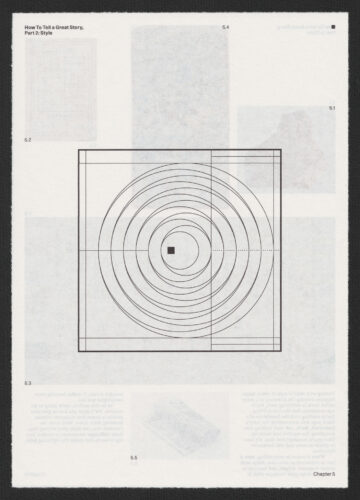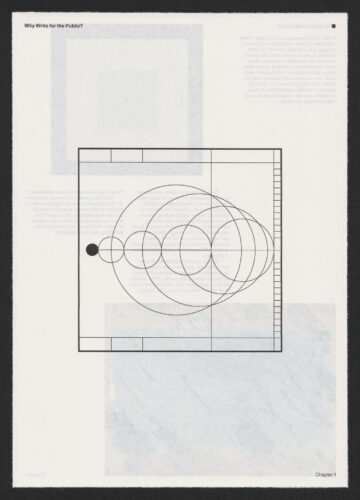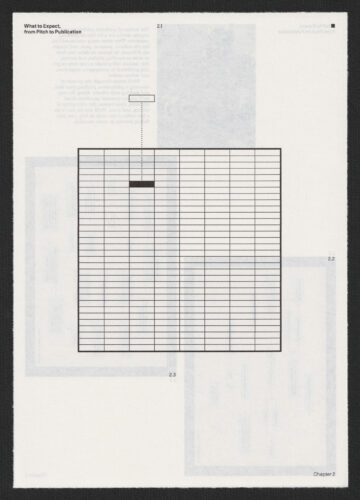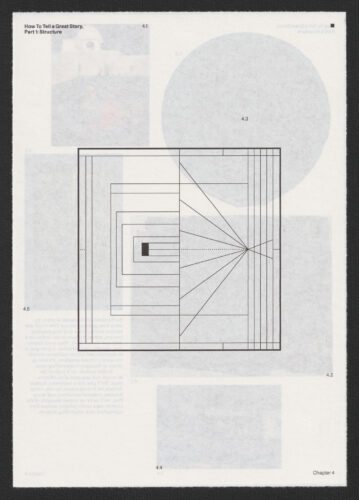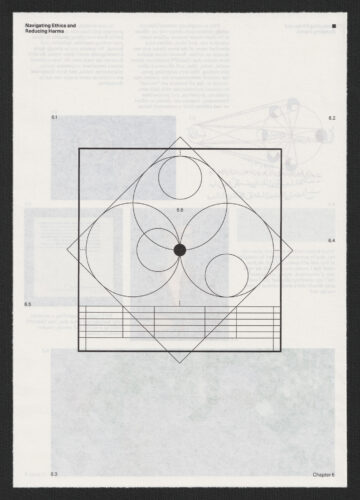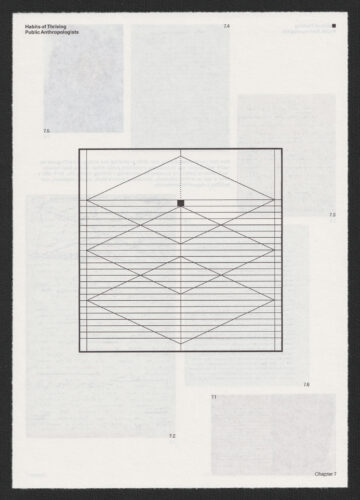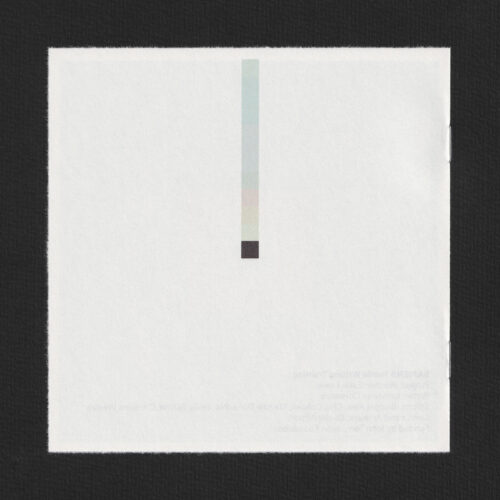Chapter 4
How To Tell a Great Story, Part 1: Structure
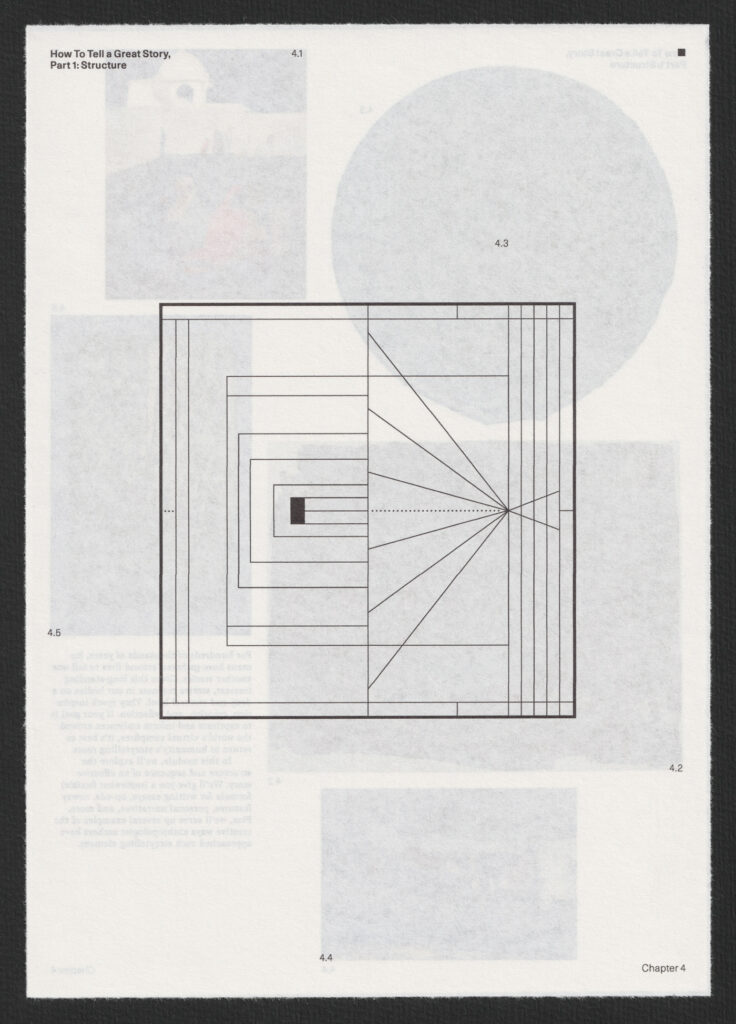
A well-told story will take a great starting point and have a clear structure follow from it.
INTRODUCTION
For hundreds of thousands of years, humans have gathered around fires to tell one another stories. Given this long-standing interest, stories resonate in our bodies on a deep and visceral level. They spark inspiration, emotion, and reflection. So if your goal is to captivate and inform audiences around the world’s virtual campfires, it’s best to return to humanity’s storytelling roots.
In this chapter, we’ll explore the structure and sequence of an effective story. We’ll give you a (somewhat flexible) formula for writing essays, op-eds, newsy features, personal narratives, and more. Plus, we’ll serve up several examples of the creative ways anthropologist authors have approached each storytelling element.
Chapter 5 will put the frosting on this multitiered storytelling cake. We’ll cover the stylistic elements that create compelling stories, including suspenseful transitions, evocative descriptions, jargon-free information, and memorable character development.
But for now, let’s focus on the framework.
A GOOD FRAMEWORK FOR STORIES

In the “Ancient Story Teller” (1940), Amrita Sher-Gil depicts an intimate moment of sharing a story.
There are countless ways to tell a story: novels, plays, epic poems, campfire yarns, creative nonfiction, and methods that don’t even involve words. Story structures vary widely by culture, audience, intention, publication outlet, and social milieu. For the purpose of these training modules, we’re focusing on the story structure most commonly used for articles in English-language popular media outlets.
This structure typically includes the following six elements, which you may later want to copy and paste into a document to help you create your story outline (see “Outlining or mapping activity” at the end of this chapter).
-
1
An intriguing lead:
One to three paragraphs that draw readers into the article through a captivating story, scene, anecdote, or surprising statement.
-
2
The nut paragraph:
One to five sentences that encapsulate your main point in a nutshell.
-
3
Background and context:
Several paragraphs that provide the history, culture, scientific theory, methods, environment, and any other information readers need to be aware of to understand the main issue.
-
4
The details:
Several paragraphs that expand on and support your main points. This could consist of statistical evidence, anecdotes, quotes, personal experiences, facts from published research papers, et cetera.
-
5
Counterpoints and challenges:
A few paragraphs that explain why people might disagree with you or what hurdles need to be overcome to accomplish the solutions you’re recommending.
-
6
Conclusion:
A brief (one paragraph or so) reflection or summary of your story that helps your main point stick in readers’ minds.
WHY USE A STORY STRUCTURE?
It might seem like following a formula will result in essays that feel formulaic. But the six-part story structure presented here leaves plenty of room for creativity. And it’s organized this way because it makes sense intellectually and emotionally from many readers’ perspectives.
By following this framework, your essays will:
- Capture readers’ attention.
- Tell your audience what the story is about and why it matters, so they can decide if they want to read it.
- Give readers the context they will need to understand the points you’re going to make.
- Explain your points through anecdotes and evidence, so readers thoroughly grasp the central question or dilemma and, especially if it’s an op-ed, have reasons to be convinced of your perspective.
- Provide counterpoints or explain potential challenges, so your audience understands the complexity of the situation or solutions.
- Provide a summary, so readers are left with a satisfying and memorable takeaway.
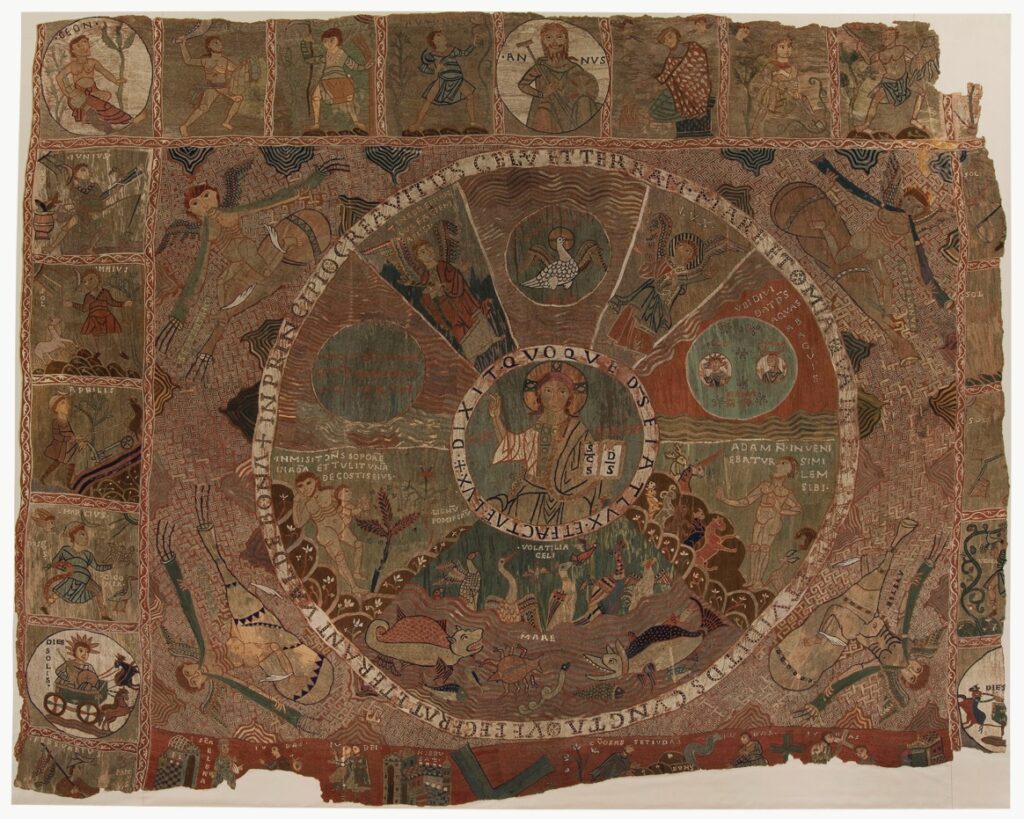
The “Tapestry of the Creation,” dating to the 11th–12th century, depicts scenes from the Christian creation story, structured in concentric circles.
Kippelboy/Wikimedia
BUT WAIT, WHAT IS A STORY?
That’s a deceptively tricky and debated concept. But when you boil it down, a story typically contains the following ingredients: One or more characters take some action, setting off a sequence of events involving conflict, challenges, and/or consequences.
The effect of this narrative on the audience is what radio host Ira Glass calls “a moment of reflection.” In other words, a story isn’t just a series of actions, such as “what I did this weekend.” It has to have a sense of momentum, of cause and effect, and, ultimately, of meaning.
That may sound complicated, but in the context of an article, an effective story can be quite simple. A classic example comes from the SAPIENS op-ed “Stop Destroying African American Cemeteries.” Archaeologist Alexandra Jones opens with this story:
In the late 19th century, a group of once-enslaved, free African Americans in Cabin John, Maryland, succeeded in creating a space they could call their own: a community called Gibson Grove. They purchased land, built homes and a church, started a school, and created a cemetery, all to protect themselves in life and death from discrimination.
But now the Maryland State Highway Administration (SHA) is attempting to claim eminent domain of a portion of this private property—a move that threatens to destroy this sacred space—in the name of highway expansion.
This threat is part of a broad problem that has been playing out across the United States since the 1940s, when many city planners argued that placing interstates through urban areas would be a good way to rid cities of “slums” and deteriorated areas. Over the decades, many African American communities have been impacted in the name of development …
This lead features characters at different time periods taking actions that result in conflict and potentially serious consequences. For the reader, it provokes feelings about systemic racism, priorities, values, injustice, and community. It’s three short paragraphs, but it’s a story.
Now let’s take a closer look at the elements of a story, along with examples of how to effectively implement them.
AN INTRIGUING LEAD
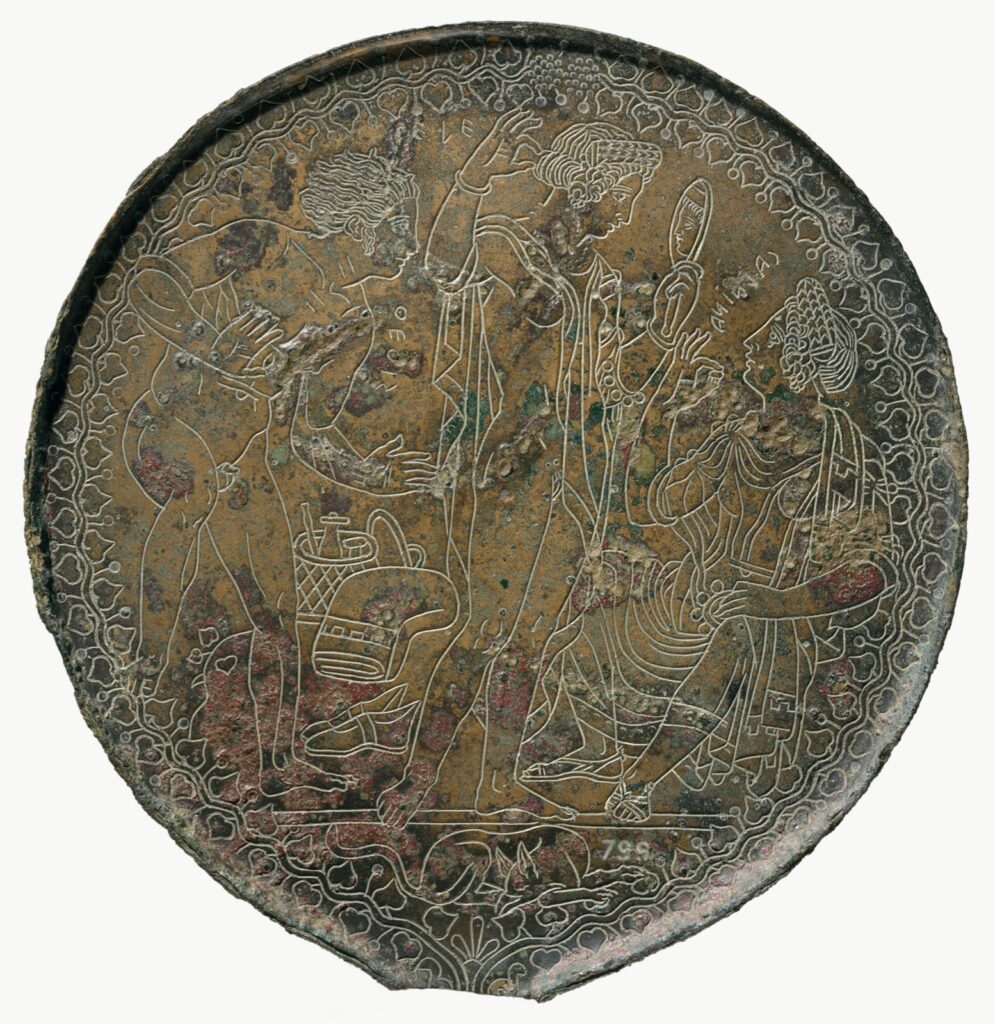
This bronze mirror, more than 2,300 years old, tells the story of Pele, Thetis, and Calaina.
With so many distractions bombarding people these days, it’s essential to grab readers’ attentions immediately. If they aren’t intrigued in the first three sentences, they’re probably going to close the tab or go back to social media scrolling.
That’s why the lead is arguably the most important part of your article—and potentially the most challenging. It can also be the most fun part to write.
The most effective way to draw readers into an essay is with a captivating story, scene, anecdote, or surprising statement. For example, archaeologist Paige Ford opened a SAPIENS op-ed with these surprising, personal, and funny two sentences:
Hi, my name is Paige, and I have generalized anxiety and panic attack disorders.
According to our lord and savior WebMD, generalized anxiety disorder (GAD) means I have an “excessive, exaggerated anxiety and worry about everyday life events for no obvious reason” and “tend to always expect disaster and can’t stop worrying about health, money, family, work, or school.”
In another SAPIENS essay, anthropologist Anita Hannig potentially leaves readers gasping by the end of the first short paragraph:
Back in February, on a chilly, windy afternoon in Cambridge, Massachusetts, a group of college students and I stood face-to-face with three ash-covered cremation furnaces at Mount Auburn Cemetery, the oldest garden cemetery in the United States. As we squeezed into the crematory, one of the students asked Joe—the no-nonsense custodian—whether we could peek inside one of the furnaces. “Not right now,” Joe said, shaking his head. “There’s someone in there.”
Often the most challenging part of writing the lead is choosing the most appropriate story to tell. If you’re writing about your research, for example, you might have dozens of riveting tales up your sleeve. And telling the most dramatic one isn’t necessarily the best option. If the story doesn’t capture the essence of your article, it will feel extraneous, and it will lack meaning and impact.
When deciding which story to tell in your lead, try writing down the main point of your essay in one or two sentences. Then ask yourself: What story is the narrative form of my primary point?
For example, when anthropologist Sophie Chao wrote “The Truth About ‘Sustainable’ Palm Oil,” her first draft started with surprising statistics, which can be an effective lead. But her editor asked if Chao knew of a story that encapsulated the main point of her essay, which was this: Though so-called sustainable palm oil is billed as eco-friendly, it’s actually harming and displacing Indigenous people.
So in her next draft, Chao wrote a story lead that powerfully and movingly brought her main point to life in narrative form:
In May 2016, Petrus, a 3-year-old Marind boy from West Papua, Indonesia, died of dysentery after drinking river water contaminated with pesticides from a nearby oil palm plantation. Petrus’ grieving parents, Marina and Bernardus, carried their child to the company headquarters some 20 kilometers away. They asked that the young boy be buried in their clan’s ancestral graveyard, located within the newly established oil palm concession. The company refused. The land was now their property, they argued. Burying the child within the plantation would attract pests that would harm the oil palm trees.
Bernardus and Marina then pleaded for Petrus to be buried in the concession’s conservation zone—a 10-meter-by-20-meter patch of sago palm grove amid a sea of monocrop oil palms—so the child could rest with his plant and animal kin. This request, too, was denied. In the interest of protecting local flora and fauna, access to the conservation zone was prohibited for non-company personnel.
Finally, Bernardus and Marina buried their child a few miles outside their village and plantation, by the side of the Trans-Irian Highway. Since then, the couple told me, their nights have been haunted by nightmares of Petrus’ frail body being trampled by trucks overloaded with palm oil fruit and by bulldozers clearing the forest to make way for oil palm. The parents wept as they described how isolated and frightened Petrus appeared in their dreams, alone by the dusty highway and severed from his plant and animal kin, never able to find rest.
“Since oil palm arrived,” Marina explains, “we Marind people have been robbed of our forest. The oil palm companies cut the forest. They also protect some forest. But now, all of the forest belongs to the companies, and we Marind have no place to live or die in peace.”
If you can’t think of a story that encapsulates your main point, you have several other options. Maybe there’s an interesting anecdote you can relate that gets to the heart of your article. An anecdote involves characters and actions but doesn’t necessarily have conflict, challenges, consequences, or an opportunity for reflection. Alternatively, you could describe a scene that transports readers to a place or situation and immerses them in a sensory experience.
Whichever option you choose, try to capture readers’ attentions with elements like multisensory details, fun quotes, or character description. For example, in the BBC Future article “The Puzzle of Neanderthal Aesthetics,” archaeologist Rebecca Wragg Sykes incorporates sight, sound, and touch into her lead scene:
Sometime between 135,000 [and] 50,000 years ago, hands slick with animal blood carried more than 35 huge horned heads into a small, dark, winding cave. Tiny fires were lit amidst a boulder-jumbled floor, and the flame-illuminated chamber echoed to dull pounding, cracking, and squelching sounds as the skulls of bison, wild cattle, red deer, and rhinoceros were smashed open.
When paleoanthropologist Paige Madison wrote “How Eating Rat Stew Serves Hobbit Research,” she began with a juicy anecdote featuring a mouthful of rat:
“Don’t forget to save every last bone!” zooarchaeologist Elizabeth Veatch called across the patio to me and our Indonesian teammates. We nodded, our mouths full of turmeric-spiced meat. Then we plucked tiny bones from our teeth and placed them in a Tupperware container.
We were sitting in a village called Teras on the island of Flores, and it was my first time eating rat. But this wasn’t just any rodent. It was a Flores giant rat (Papagomys armandvillei), which grows as long as a raccoon and tastes like oily rabbit, with a strong stench.
Nor was this just any lunch. Veatch and her colleagues will examine these butchered, stewed, and chewed rat bones to uncover secrets about the diets and behaviors of mysterious ancient hominins.
Scenes or anecdotes can be an effective way of illustrating your main points. In his Aeon essay “Out of the Forest,” archaeologist Patrick Roberts explores why rainforests are under-researched in human origins studies. He began his essay with this lead:
In a sweltering tropical rainforest on an island in the middle of the Indian Ocean, I started to appreciate why archaeologists and anthropologists had long ignored “jungles” in their search for humanity’s origins. The mosquitoes, leeches, harsh terrain, and difficult footing were bad enough, but now a summer monsoon downpour was rapidly approaching. As we slogged on under a canopy of green, the forest grew quiet. The usual chattering life had been smart enough to seek shelter, leaving us alone to face the monsoon rains.
In addition to stories, anecdotes, and scenes, there are a variety of other effective ways to begin an essay, such as creative analogies, surprising statements, and leads that are more experimental or poetic in form. But no matter how creative you get, the key is always to capture the essence of your article and intrigue your reader.
In an Aeon essay about human evolution, anthropologist John Hawks opens with this ingenious analogy:
Until recently, anthropologists drew the human family tree in the same way that my 10-year-old son solves a maze. He finds it much easier to work from the end to the beginning, because blind alleys lead with depressing sameness away from the start. In just this way, scientists once traced our own lineage from the present into the past, moving backward through a thicket of fossil relatives, each perched upon its own special branch to extinction.
This approach yielded the now-ubiquitous image of the human family tree, with Homo sapiens—the one and only living hominid—sitting alone, seemingly inevitable, at the top. It’s a powerful metaphor, but it also turns out to be a deeply mistaken one.
In a SAPIENS essay about how people can inadvertently hurt the animals they care for, archaeologist Melina Seabrook began with this unexpected yet totally apropos sentence: “Animals were harmed in the making of this story.”
And in her essay “How a Coerced Confession Shaped a Family History,” sociocultural anthropologist Deidre H. Crumbley shows that a simple yet unconventional beginning can draw readers in:
Race: Black
Sex: Male
Crime: Assault [with] Intent to Ravish
Verdict: Guilty
This is how Cousin James is described in the July 14, 1930, court records from Edgefield, South Carolina.
THE NUT PARAGRAPH
The nut paragraph, or “nut graf” in journalism speak, usually consists of one to five sentences that encapsulate your main point in a nutshell.
Think of it as a signpost on a hiking trail. If there’s clear signage at a trailhead, with a map showing you the trail leads to a waterfall and petroglyphs, you can proceed with a sense of confidence and anticipation. It’s the same with a clear nut graf: It lets readers know what they can expect to learn. But if a path doesn’t have a signpost, or an article doesn’t have a clear nut graf, readers are very quickly going to say to themselves, “I have no idea where this is going. I’ll just stop here.”
If you’ve written your pitch, you may have already written your nut graf—or something very close to it. The nut graf incorporates two main elements of a pitch: Why does this matter? And why does it matter now?
In the aforementioned Aeon article “Out of the Forest,” the author emphasizes a sense of timeliness and significance in his nut graf (somewhat condensed here):
Throughout this vast span of human history, tropical forests remained the challenging habitats we “left behind.” But during the past few years, several truly remarkable sites and findings have catapulted tropical forests to the centre of key debates in human evolution. … What was found … confounds accepted narratives about Homo sapiens and its ancestors. It forces us to ask new questions of our origins. Does the hominin story in fact begin in tropical forests? And, if so, does this change how we understand ourselves as a species?
In her SAPIENS essay about people inadvertently harming animals, Seabrook’s nut graf uses her research on goats as a springboard to explore a larger issue:
As I worked to solve the mystery of these [goats], I realized they hold a lesson for our present-day relationships with kept creatures: People may inflict harm on the animals they care about most.
In her essay on “sustainable” palm oil, Chao reinforces and personalizes her nut graf with a quote:
Yet despite their purported benefits, “green” palm oil initiatives are often criticized by Indigenous peoples, who find themselves dispossessed or displaced by agribusiness. Among Marind communities in the Merauke district of West Papua, where I have been carrying out fieldwork since 2013, these projects give rise to consternation, frustration, and sadness. They disconnect the Marind from their ancient relationship with forest organisms they view as kindred spirits and as companion species in both life and death.
“People think palm oil is green because there are conservation projects. But no one sees the blood and the violence,” says Perpetua, a young Marind woman. “Protected, not protected—it doesn’t matter. All that land was taken from us without our permission.”
Need more examples of the nut graf? Check these out: here, here, and here.
You can think of the lead and nut graf as the main elements in the first section of your article. In this first section, you might also include information about who you are and why you’re writing about your topic, as Chao did above. This can establish your expertise, help readers understand why they should value your insights, and spark a connection with readers.
In addition, you might need to include a brief amount of backstory and context. But keep it to a minimum; you’ll go into more detail in the second section.
The first section should be as fast-paced as possible. People are deciding whether they want to read the article, and if it feels like the pace is dragging, they’ll stop reading. So the first section should have momentum that propels readers into the rest of the article.
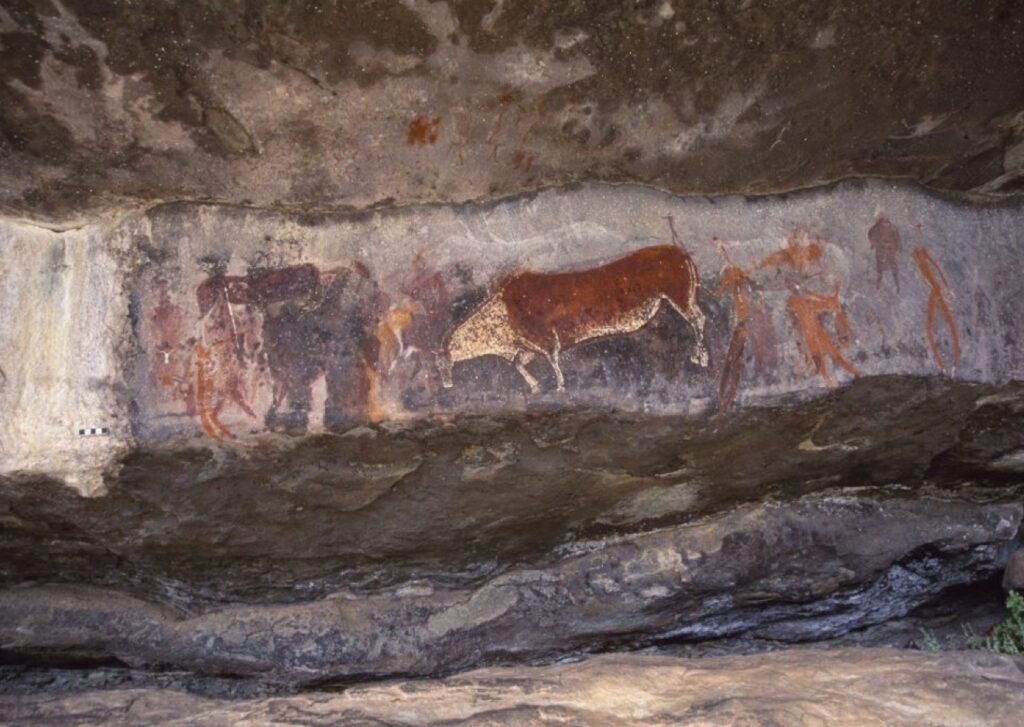
Based on oral traditions among the San of southern Africa, this rock art panel with mythical animals and people has been interpreted to relate a story about the interaction between the spirit world and human shamans.
TARA/David Coulson
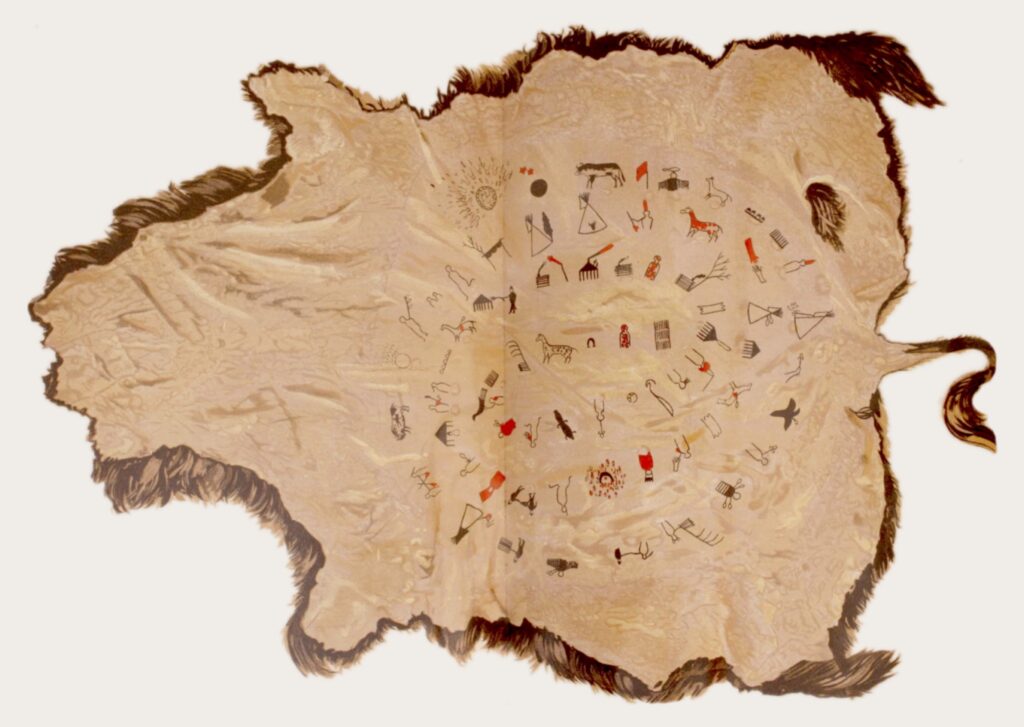
This winter count, which illustrates one symbol for each year’s most significant event, by Lone Dog documents Yanktonais history, from 1800–1871.
Garrick Mallery/Wikimedia
BACKGROUND AND CONTEXT
This is where you’ll explain the history, culture, scientific theory, methods, environment, or any other information readers need to be aware of to understand the issue.
At this point, readers have (conditionally) committed to reading the article, so you can slow the pace slightly. But it’s important not to overwhelm your audience, so the main thing to determine in this section is: What information should I include, and what should I leave out? To help you decide, ask yourself: What information is directly related to my nut graf and supports my main points?
April Zhu found herself faced with that question while writing “What Kenya’s Killer Cops Reveal About Police Culture.” She needed to describe Kenya’s colonial history to explain the origins of Nairobi’s harsh law enforcement system. That’s a complex topic.
So Zhu began her backstory section with a sentence that signposted to readers what they would learn: “The foundations of Nairobi’s social divisions and brutal, bifurcated policing system were laid in the first few decades of its existence.” Then she carefully chronicled only the history that explained Nairobi’s harsh, two-pronged policing system. This ensured that the pace wasn’t too slow, and readers weren’t bogged down with information.
The background or context section can also be the place to present research and general facts. For example, an author might zoom out in this section to talk about a health condition, as in this article about diabetes or this essay on placenta rituals. It may be the place to explain the nitty-gritty of a legal issue, as in this op-ed about the exclusionary rules of the Fulbright-Hays fellowship. This section could also provide a sense of place, as in this feature about defending the San Pedro River in Mexico.
Note that not every essay needs a background and context section. Some personal essays may not need it because the entire article is backstory. Some op-eds don’t require it if the issue is well understood or if the very act of making your points involves providing history and context.
THE DETAILS
This is where you expand on and support your main points. You’ll probably provide evidence in the form of statistics and/or facts from published research papers (with hyperlinks). You might weave together one or more anecdotes with quotes from people you’ve interviewed. You might describe insights from personal experiences.
As ever, keep your reader in mind. They’ve continued reading up to this point because they want to understand what your nut graf told them you would deliver. So when you’re deciding what to include and what to leave out, your nut graf is your North Star, and your destination is your readers’ attentions and greater understanding.
As an example, let’s look at paleoanthropologist Bruce Hardy’s essay “Did Neanderthals Make Art?” The author’s nut graf consists of two straightforward questions:
So, what is the evidence for Neanderthal art? And why are so many people skeptical that Neanderthals had the cognitive capability to make paintings, ornamentation, and other symbolic creations?
His details section consists of subheaded sections that explore cave paintings, stone circles, engraved bones, and jewelry. Under each subhead, he provides evidence in the form of scientific studies, explanations of dating methods, and descriptions of the archaeological finds.
By contrast, in “How a Coerced Confession Shaped a Family History,” the details section mainly consists of one story, as told by Crumbley’s mother. (It begins under the subhead “WHAT HAD HAPPENED: BERNICE’S STORY.”) Then, because the author is relating the story in part to illustrate larger points about racism, she takes a more telescopic view and provides statistics about racial disparities in sentencing.
COUNTERPOINTS AND CHALLENGES
Presenting counterarguments to your main points and perspective enhances your credibility and conveys the complexity inherent to the issue.
Not every article needs a counterpoint section. However, if your perspective is contentious, you’ll need to explain why some people might disagree with you. Or if you’re writing about a solution to a problem, and that solution would require overcoming hurdles, you’ll need to explain those challenges.
When you are structuring your essay, you could weave counterpoints and challenges into your arguments. Or you could put them in their own section after you make your points.
In the Neanderthal art story, the author interwove his counterarguments because he was discussing several archaeological finds that were scientifically analyzed using different methods. It made sense to present readers with a point and counterpoint for each purported artwork.
On the other hand, if you were writing about a community program that addresses a problem, it might make more sense to describe all the program’s methods and solutions and then explain why some people oppose the program. The author of the San Pedro River piece uses this approach, presenting the challenges river defenders face in their work under the subheading “VANQUISHERS OF THE DESERT.”
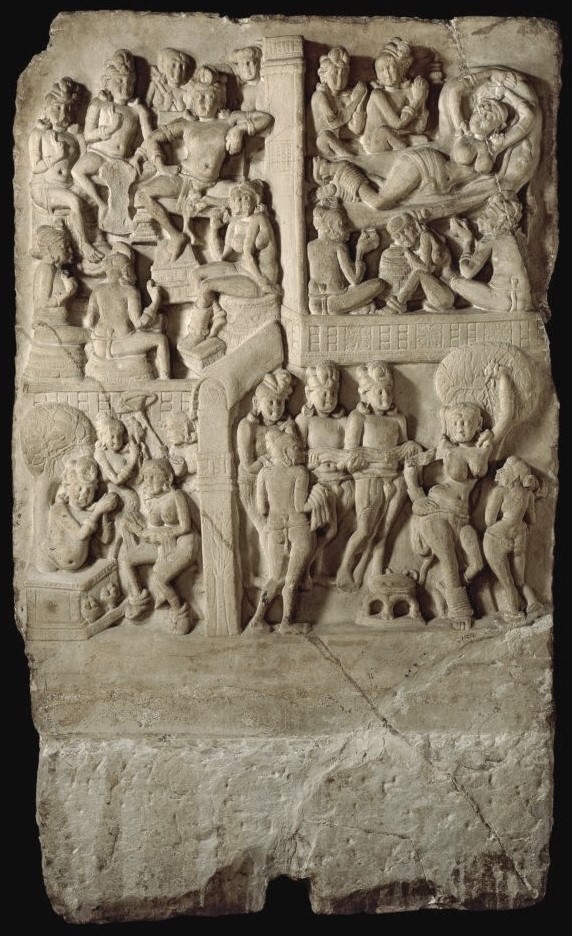
This stone sculpture depicts a series of scenes from the Buddha’s life.
CONCLUSION
You may recall being told in school that the way to write an essay is: “Say what you’re going to say. Say it. Then say it again.”
While there are elements of truth in this advice, it’s misleading because it implies that you’re supposed to repeat yourself ad nauseam or, at best, break out the thesaurus and use slightly different words to say the same thing over and over. That’s boring. And it’s a missed opportunity to give readers a satisfying, moving, or galvanizing takeaway. With a little creative thinking, you could instead write a conclusion that:
- transports readers to the future with a message about what needs to be done next,
- circles back to your lead story while offering new commentary,
- hammers home the consequences of an issue or what’s at stake if the actions you outlined aren’t taken,
- makes readers laugh or get teary-eyed, or
- offers a motivating call to arms.
Let’s look at a few effective examples.
In the Aeon essay “Out of the Forest,” Roberts’ final paragraph rounds back to his earlier reflections on humanity’s past relationships with rainforests. Then he ends with a thought-provoking statement about our future relationship with these ecosystems:
Tropical forests are, and have always been, a key part of our remarkable human story. They have been constant companions along our journey. The challenge now is to ensure that they remain by our side during whatever comes next.
Anthropologist Thomas W. Pearson concludes his essay about his daughter’s Down syndrome diagnosis by crystallizing the lessons he’s learned from his almost 4-year-old:
My daughter’s Down syndrome has not changed my life in the ways I once feared. It has only clarified what’s truly important.
In a New York Times book review about the origins of walking, Rebecca Wragg Sykes closes with an invitation to ponder and appreciate the wonder of walking:
DeSilva is a genial companion on this stroll through the deep origins of walking. Sometimes we amble along listening to fieldwork yarns, other times the way is steeper, requiring more concentration to absorb complex ideas. But always the view from the top is illuminating. Next time you crest a rise, take a moment to look down at your legs and ponder what it really took to get you there.
And in these last three examples, the endings contain spoilers or wouldn’t fully make sense if you saw them out of context, so you’ll have to read the articles to get the full effect:
Anthropologist Charlotte Williams wraps up her essay “Excavating My Dad’s Life” with a description of her most moving find among her late father’s possessions, potentially leaving readers a little misty-eyed.
In “Why Are People Who Use Illegal Drugs Demonized?,” anthropologist Gideon Lasco ends with a mic drop by exposing the occasional hypocrisy involved in using harsh tactics against people who take drugs.
And in his essay on Icelandic volcanoes, biocultural anthropologist Adam Netzer Zimmer finishes with a fun reference to an amusing description he had presented at the beginning of the essay.
In the end, close your essay with the thought, argument, or image that you want to stay with your readers long after they’ve read your final word.
Activities
Plan and Begin Writing
-
Outlining or mapping activity
If you’re ready to start writing an article, it can be helpful to begin with an outline. And, no, we don’t mean those Roman numeral outlines from grade school. Instead, you could copy and paste the six-part story structure listed near the top of this chapter. Then, underneath the appropriate section, jot down a couple of details about a story you want to tell, copy the nut graf (the “why” and “why now” sentences from your pitch), paste links to papers you plan to reference, and include quotes from people you interviewed. You get the idea. Some people find it helpful (and more fun) to put each section in a different color so it’s easier to keep track of where you are if your outline gets long.
If outlining isn’t your thing, you might try concept maps, storyboarding, or notecards that you can shuffle around. Or record yourself talking through a story (alone or with another person) and then listen back to see if it flows.
-
Reverse-outlining activity
Pick a published article you like and identify each section: lead, nut graf, background, et cetera. Think about (and write down, if you wish) the purpose of each section and what it contributes to the overall piece. What would you like to emulate, and what would you do differently that might be more effective?
-
Drafting activity
Write the first draft of your essay. Don’t worry yet about writing beautifully polished sentences—just get all the structural and individual components down, even if they’re pretty rough. Then go back over it and make sure you can identify each element: lead, nut graf, counterpoints, and so on. Is any section missing? Is any part unnecessary? If so, fix the structure. In the next section, we’ll go over how to polish your writing and make it shine.
